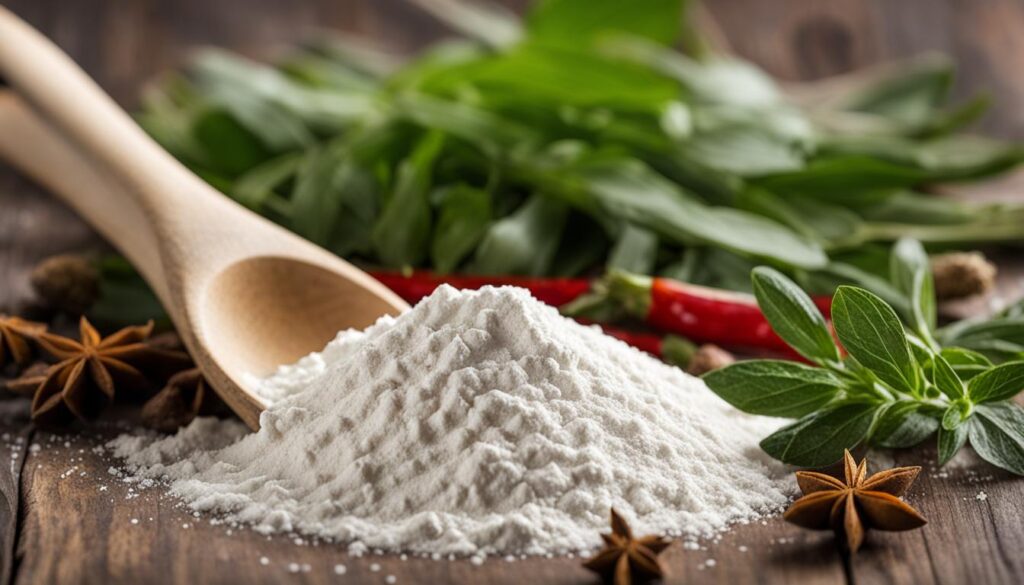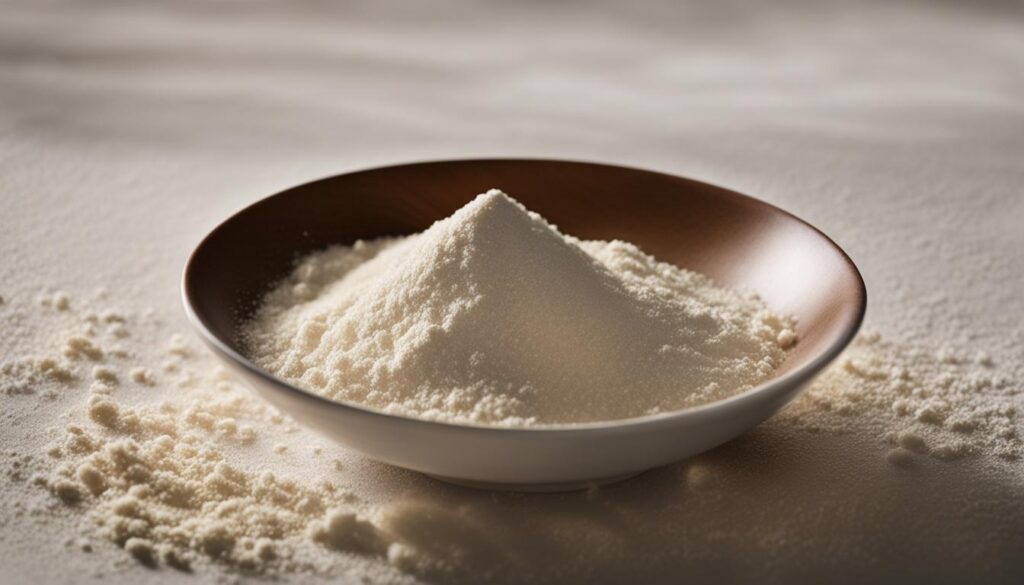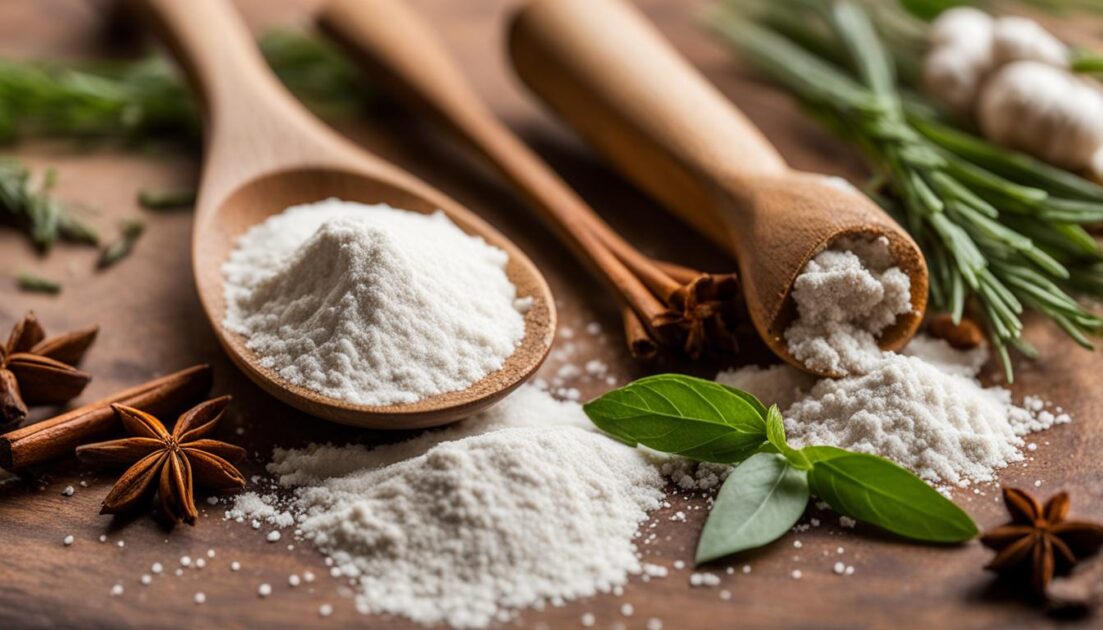Arrowroot powder, derived from the root and rhizome of the arrowroot plant, has gained popularity in the culinary world. However, its benefits go beyond the kitchen. Studies suggest that arrowroot may have potential health benefits, particularly for digestion and overall well-being. In this article, I will explore the various uses and potential advantages of arrowroot powder.
Arrowroot powder has a long history of traditional use and is known for its gentle and soothing properties. It is considered easily digestible and gluten-free, making it suitable for individuals with dietary restrictions or sensitive digestive systems. Consuming arrowroot powder may help alleviate stomach pain and diarrhea in people with irritable bowel syndrome (IBS). Additionally, its high fiber content can support weight loss efforts by promoting a feeling of fullness and reducing cravings.
While there is limited scientific evidence to support many of the claims surrounding arrowroot powder, it has been used in traditional medicine for treating wounds and toxins. Furthermore, arrowroot powder is believed to have cosmetic and skincare applications due to its hypoallergenic nature. However, more research is needed to fully understand the potential benefits of arrowroot powder in these areas.
Whether you are looking to improve your digestion, manage your weight, or explore alternative skincare options, arrowroot powder may be worth considering. In the following sections, we will delve deeper into the uses, effectiveness, side effects, and nutritional value of arrowroot powder. We will also examine its role in Ayurveda and compare it to other common starches. Stay tuned to learn more about this versatile and potentially beneficial ingredient.
Key Takeaways:
- Arrowroot powder may offer potential health benefits, particularly for digestion and weight management.
- It is considered gluten-free and easily digestible, making it suitable for individuals with dietary restrictions or sensitive digestion.
- Some studies suggest that arrowroot powder may alleviate stomach pain and diarrhea in people with irritable bowel syndrome (IBS).
- Arrowroot powder has been used in traditional medicine for treating wounds and toxins and may have cosmetic and skincare applications.
- Further research is needed to fully understand the potential benefits and uses of arrowroot powder.
Overview of Arrowroot

Arrowroot is a plant with an underground stem called a rhizome that is used as a source of starch. It is commonly used in foods, such as cookies, and as an ingredient in cooking. However, it is often replaced with cheaper starches like potato, corn, wheat, or rice starch.
While arrowroot has been used in traditional medicine for various conditions, there is limited scientific evidence to support many of these uses. Some studies suggest that arrowroot may help reduce cholesterol levels, but more research is needed to understand how it works for stomach and intestinal problems and other uses.
Despite the lack of extensive scientific research, arrowroot continues to be a popular choice in cooking and baking due to its unique properties and potential health benefits.
| Benefits | Uses |
|---|---|
| 1. Easily digestible | – In gluten-free and paleo baking |
| 2. Potential for improved digestion | – In soups, stews, and sauces for thickening |
| 3. Gluten-free alternative | – In baby food as a natural thickener |
| 4. Suitable for individuals with dietary restrictions | – In skincare products for its soothing properties |
While further scientific studies are necessary to validate the various uses and effectiveness of arrowroot, its unique properties make it a popular choice among individuals exploring alternative ingredients for their health and dietary needs.
Uses and Effectiveness of Arrowroot

While there is limited scientific evidence, arrowroot has been used for various purposes. It has shown some potential in reducing stomach pain and diarrhea in people with irritable bowel syndrome (IBS) when taken as powdered arrowroot with meals. It has also been used to soothe mucous membranes, like the mouth and gum linings. Additionally, arrowroot has been used in baby food products and skincare products due to its gentle and hypoallergenic nature. Some believe that arrowroot can support weight loss due to its high fiber content and ability to keep you feeling full. However, more research is needed to confirm these uses and determine the effectiveness of arrowroot for each specific purpose.
Arrowroot has shown potential in reducing stomach pain and diarrhea in people with IBS when taken as a powdered supplement with meals. It can also be used to soothe mucous membranes and is commonly found in baby food and skincare products due to its gentle nature.
- Reduces stomach pain and diarrhea in people with IBS
- Soothes mucous membranes
- Used in baby food products
- Gentle and hypoallergenic for skincare
- Potential support for weight loss
To better understand the uses and effectiveness of arrowroot, further research is required to validate these claims and determine the specific benefits it offers for different purposes.
| Use | Potential Effectiveness |
|---|---|
| Reducing stomach pain and diarrhea in people with IBS | Limited scientific evidence |
| Soothing mucous membranes (mouth and gums) | Limited scientific evidence |
| Used in baby food products | Traditionally used, limited scientific evidence |
| Used in skincare products | Traditionally used, limited scientific evidence |
| Potential support for weight loss | Some evidence, more research needed |
Side Effects and Precautions of Arrowroot
While arrowroot is generally considered safe when used in foods, it is important to be aware of potential side effects and take necessary precautions. Excessive consumption of arrowroot may lead to constipation and stomach discomfort. It is advised to consume arrowroot in moderation and stick to recommended food amounts to avoid these issues.
However, it is important to note that limited information is available about the safety and side effects of arrowroot when used in larger amounts or applied to the skin. As such, it is recommended to exercise caution and avoid exceeding the recommended dosage when using arrowroot for purposes other than food.
When it comes to consuming arrowroot during pregnancy and breastfeeding, it is important to note that there is not enough reliable information to determine its safety in larger amounts. Therefore, it is advisable for pregnant and lactating individuals to stick to food amounts of arrowroot and consult with a healthcare professional before incorporating it into their diet.
As with any dietary or skincare product, it is always recommended to consult with a healthcare professional before using arrowroot, especially if you have any underlying health conditions or are taking any medications. This will help ensure that it is safe for you to use and minimize any potential risks or adverse reactions.
Interactions with Arrowroot

While arrowroot is generally safe for consumption, it is always important to inform your healthcare provider about any dietary supplements or alternative therapies you are using. This will help ensure there are no potential interactions with any medications or treatments you may be undergoing.
Although there is currently no information available regarding any specific interactions with arrowroot, it is still wise to exercise caution. By providing your healthcare provider with a comprehensive overview of your health and wellness routine, they can assess the potential for any interactions or contraindications.
If you are taking any prescription medications or undergoing any medical treatments, it is particularly crucial to consult with your healthcare provider before incorporating arrowroot into your diet or using it for other purposes. This proactive approach will help safeguard your health and prevent any adverse outcomes.
Additionally, it is worth noting that the potential interactions of arrowroot with other drugs or treatments, if any, have not been extensively studied. Therefore, it is essential to always seek professional medical advice to ensure your safety and well-being.
Dosing of Arrowroot

As of now, there is no established dosing recommendation for arrowroot due to the limited scientific information available. The appropriate dose of arrowroot may vary depending on factors such as age, health, and other specific conditions. It is important to follow the directions on product labels and consult with a healthcare professional before using arrowroot or any other natural product.
Arrowroot can be consumed in various forms, including arrowroot powder, arrowroot starch, or arrowroot flour. The dosage may differ based on the intended use and individual preferences. It is advisable to start with small quantities and gradually increase the dose based on the desired effects and tolerance.
When using arrowroot as a thickening agent in cooking or baking, it is recommended to follow recipes that provide specific measurements for the best results. Arrowroot’s thickening power is higher compared to cornstarch, so it is better to use less arrowroot when substituting it for other starches.
In terms of skincare, arrowroot can be applied topically in the form of masks and pastes. It is essential to conduct a patch test before using arrowroot on larger areas of the skin, especially if you have sensitive skin or are prone to allergies.
In summary, as there is no established dosing recommendation for arrowroot, it is crucial to exercise caution and consult with a healthcare professional or follow product labeling instructions. The appropriate dosage of arrowroot may vary depending on individual needs and specific health conditions.
Table 6: Arrowroot Dosage Guidelines
| Form of Arrowroot | Common Dosage | Notes |
|---|---|---|
| Arrowroot powder for cooking/baking | As per recipe instructions | Follow specific recipe measurements for best results |
| Arrowroot paste for skincare | Apply a thin layer of paste to the desired area | Conduct a patch test and discontinue use if any adverse reaction occurs |
Note: The dosage recommendations provided above are general guidelines and may vary depending on individual needs and health conditions. It is always advisable to consult with a healthcare professional before using arrowroot or any other natural product.
Nutritional Value of Arrowroot

Arrowroot is a nutrient-dense ingredient that provides several essential nutrients. It is a good source of carbohydrates, protein, and fiber, making it a valuable addition to a balanced diet. Additionally, arrowroot contains important minerals such as calcium, iron, magnesium, phosphorus, potassium, and trace amounts of other minerals.
Here is a breakdown of the nutritional content in 100 grams of arrowroot:
| Nutrient | Amount |
|---|---|
| Carbohydrates | 88 grams |
| Protein | 4.24 grams |
| Fiber | 3.4 grams |
| Calcium | 6 milligrams |
| Iron | 2.7 milligrams |
| Magnesium | 94 milligrams |
| Phosphorus | 57 milligrams |
| Potassium | 454 milligrams |
The nutritional composition of arrowroot makes it particularly beneficial for individuals with dietary restrictions or specific nutritional needs. With its rich array of nutrients, arrowroot can contribute to overall health and well-being.
Arrowroot in Ayurveda

In Ayurveda, arrowroot is highly regarded for its digestive stimulating properties and its ability to balance Pitta and Vatta doshas. This versatile herb is considered cooling and is known to address various health conditions, including digestive disorders and skin irritations. Ayurvedic practitioners recommend incorporating arrowroot into daily routines, boiled in milk or water, to harness its potential health benefits.
Benefits for Digestion
Arrowroot has long been used to promote healthy digestion in Ayurvedic practices. Its gentle nature and ability to soothe the digestive tract make it an excellent choice for individuals struggling with digestive issues such as indigestion, bloating, and acid reflux.
Balances Pitta and Vatta Doshas
According to Ayurveda, imbalances in Pitta and Vatta doshas can lead to various health problems. Arrowroot is believed to have a cooling effect on the body and possesses properties that help restore balance to these doshas. By balancing these energies, arrowroot contributes to overall well-being and optimal health.
Natural Remedy for Digestive Disorders
Arrowroot’s medicinal properties are often utilized to address a range of digestive disorders. From soothing an upset stomach to alleviating symptoms of gastritis, arrowroot plays a valuable role in promoting digestive health in Ayurvedic medicine.
Skin Irritations and Arrowroot
Arrowroot is also valued in Ayurveda for its potential benefits in treating skin irritations. Its cooling and soothing properties are believed to help calm inflamed or irritated skin, making it a popular choice for natural skincare remedies.
Comparison with Corn Starch
Arrowroot and corn starch are both commonly used as thickening agents in cooking. However, there are some key differences between the two. Arrowroot is often considered a healthier alternative to corn starch, particularly for individuals with gluten sensitivities or allergies.
One notable advantage of arrowroot is that it is naturally gluten-free. This makes it an excellent choice for those following a gluten-free diet or with celiac disease, as corn starch may be derived from gluten-containing grains. Arrowroot is also easily digestible, making it a suitable option for individuals with sensitive digestion.
Beyond its gluten-free properties, arrowroot offers a higher nutrient content compared to corn starch. It contains calcium, iron, magnesium, phosphorus, potassium, and trace amounts of other minerals, providing additional health benefits. In contrast, corn starch is primarily a source of carbohydrates without significant nutritional value.
Another benefit of arrowroot is its lower glycemic index compared to corn starch. The glycemic index measures how quickly a carbohydrate raises blood sugar levels. Arrowroot has a lower glycemic index, which can be beneficial for individuals with diabetes or those who are monitoring their blood sugar levels.
Both arrowroot and corn starch can be used in various recipes as thickening agents. However, arrowroot may offer additional health benefits compared to corn starch due to its gluten-free nature, higher nutrient content, and lower glycemic index.
Arrowroot vs. Corn Starch: A Comparison
| Arrowroot | Corn Starch |
|---|---|
| Naturally gluten-free | May contain gluten |
| Easily digestible | Digestion may vary |
| Higher nutrient content | Primarily a source of carbohydrates |
| Lower glycemic index | Higher glycemic index |
When using arrowroot or corn starch in your recipes, consider your specific dietary needs and health goals. While both serve as effective thickening agents, arrowroot may offer additional advantages for individuals with gluten sensitivities, those seeking nutrient-rich alternatives, or individuals monitoring their blood sugar levels.
Arrowroot in Traditional and Indigenous Cultures

Arrowroot has been a significant part of traditional and indigenous cultures for centuries. It has been valued for its diverse uses as a food source and for its medicinal properties. Let’s explore the historical significance of arrowroot in different cultural contexts.
In the Caribbean, arrowroot was a staple food that provided sustenance and energy to the local communities. It was believed to have powerful healing properties and was used to treat arrow wounds and draw out toxins from the body. This versatile plant played a crucial role in their diets and as a natural remedy for various ailments.
In indigenous cultures of South America, arrowroot had multiple applications. It was utilized in traditional medicine for its potential health benefits. This included treating digestive disorders, skin irritations, and other common ailments. Furthermore, arrowroot was employed in the manufacturing of paper and other products, showcasing its versatility.
While the historical uses of arrowroot in these cultures highlight its potential benefits, further research is needed to fully understand its efficacy. These traditional practices provide valuable insights that can guide future scientific exploration into arrowroot’s health properties.
Arrowroot in Traditional and Indigenous Cultures
| Culture | Significance |
|---|---|
| Caribbean | Staple food and believed to treat arrow wounds and toxins |
| South America | Utilized in traditional medicine; used in paper and product manufacturing |
Conclusion
In conclusion, arrowroot powder has gained popularity for its potential health benefits and versatility in various applications. With its natural properties, arrowroot offers several advantages for digestion, weight loss, and dietary needs. As a gluten-free and easily digestible option, it is a suitable choice for individuals with specific dietary restrictions or sensitive digestion.
However, it is important to note that while arrowroot powder holds promise, there is limited scientific evidence to fully support all of its claimed benefits. More research is needed to understand and validate the specific advantages of using arrowroot in different contexts.
Before incorporating arrowroot powder into your routine, it is always advisable to consult with a healthcare professional. They can provide personalized guidance and ensure that adding arrowroot powder to your diet aligns with your overall health goals and existing medical conditions.
FAQ
What are the benefits of arrowroot powder for digestion and health?
Arrowroot powder may help with digestion, reduce stomach pain and diarrhea in people with irritable bowel syndrome (IBS), and support weight loss. It is also considered gluten-free and easily digestible, making it suitable for individuals with dietary restrictions or sensitive digestion. However, more research is needed to fully understand the potential benefits of arrowroot powder.
What is arrowroot and how is it used?
Arrowroot is a plant with a root and rhizome that is used as a source of starch. It is commonly used in foods and cooking, such as cookies, as a thickening agent. It can also be used in gluten-free baking as a substitute for wheat flour.
How effective is arrowroot for digestion and other uses?
While there is limited scientific evidence, some studies suggest that arrowroot may help reduce stomach pain and diarrhea in people with IBS. It has also been used in baby food products and skincare products due to its gentle and hypoallergenic nature. However, more research is needed to confirm these uses and determine the effectiveness of arrowroot for each specific purpose.
Are there any side effects or precautions when using arrowroot?
Arrowroot is generally considered safe when used in foods, although excessive consumption may cause constipation and stomach discomfort. However, there is limited information available about the safety and side effects of arrowroot when used in larger amounts or applied to the skin. It is advised to stick to food amounts when consuming arrowroot, especially during pregnancy and breastfeeding, as there is not enough reliable information to determine its safety in larger amounts. It is recommended to consult with a healthcare professional before using arrowroot.
Are there any interactions with arrowroot?
As of now, there is no information available regarding any interactions with arrowroot. However, it is always a good idea to inform your healthcare provider about any dietary supplements or alternative therapies you are using to ensure there are no potential interactions with any medications or treatments you may be undergoing.
What is the dosing recommendation for arrowroot?
There is currently no established dosing recommendation for arrowroot due to the limited scientific information available. The appropriate dose may vary depending on factors such as age, health, and other specific conditions. It is important to follow the directions on product labels and consult with a healthcare professional before using arrowroot or any other natural product.
What is the nutritional value of arrowroot?
Arrowroot is a nutrient-dense ingredient that provides several essential nutrients. It is a good source of carbohydrates, protein, and fiber. Additionally, it contains calcium, iron, magnesium, phosphorus, potassium, and trace amounts of other minerals.
How is arrowroot used in Ayurveda?
In Ayurveda, arrowroot is valued for its digestive stimulating properties and its ability to balance Pitta and Vatta doshas. It is considered a cooling herb and is used to treat various health conditions, including digestive disorders and skin irritations.
How does arrowroot compare to corn starch?
Arrowroot is considered a healthier alternative to corn starch, especially for individuals with gluten sensitivities or allergies. Arrowroot is naturally gluten-free, easily digestible, and has a higher nutrient content than corn starch.
What is the historical use of arrowroot in traditional and indigenous cultures?
Arrowroot has a long history of use in traditional and indigenous cultures. It has been used for centuries as a food source and for its medicinal properties. In the Caribbean, arrowroot was a staple food and was believed to have the ability to treat arrow wounds and draw out toxins.






